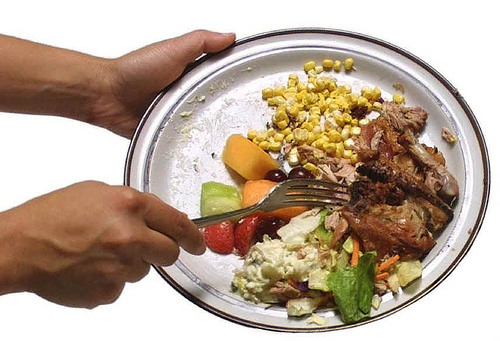When my info-larder gets too packed, it’s time to serve up some choice nuggets from around the web.
———
Nuke disaster hits Japan’s food supply
Note to planners: Don’t plunk highly volatile industrial projects onto rich farmland. Doing so ensures that industrial disasters will quickly cascade into food crises. Tragically, Japan’s Fukushima region isn’t just a source of nuclear-derived electricity. It’s also a major source of milk and vegetables — and its farmland has already been impacted by the disaster at the Fukushima nuclear power plant. From Saturday’s The New York Times:
As Japan edged forward in its battle to contain the damage at its ravaged nuclear power plants on Saturday, the government said it had found higher than normal levels of radioactivity in spinach and milk at farms up to 90 miles away from the plants, the first confirmation that the unfolding nuclear crisis has affected the nation’s food supply.
And early Monday, a World Health Organization official said the irradiated-food problem is “a lot more serious than anybody thought in the early days when we thought that this kind of problem can be limited to 20 to 30 kilometers [12 to 19 miles] … It’s safe to suppose that some contaminated produce got out of the contamination zone.” Furthermore, “high levels of radioactive iodine” have been detected in tap water near the failed plant, Reuters reports.
Strawberry fields for never
Remember methyl iodide, the pesticide fumigant that’s so reliably carcinogenic that scientists use it to induce cancer cells in lab tissue? In 2007, Bush’s EPA approved it for use over the objections of myriad scientists. (I told this classic tale of crony capitalism at the time). In California — where the poison will likely be used in the state’s vast strawberry industry — the Department of Pesticide Regulation (DPR) followed the Bush EPA’s lead, again defying scientific consensus [PDF] and approving methyl iodide at the urging of then-Gov. Arnold Schwarzenegger (R) late last year.
The DPR’s director, Mary-Ann Warmerdam, took plenty of heat for this strong stand on behalf of the chemical industry. But don’t pity her. Last week, she resigned her post — and snapped up a job with the chemical industry, reports Bridget Huber on Civil Eats. She’ll now be answering to the shareholders of Clorox, not the California public. On the positive side, Warmerdam’s departure raises the possibility that the egregious approval could be reversed, Huber reports. It’s pretty much up to new Gov. Jerry Brown (D), who will appoint Warmerdam’s replacement. Do the right thing, Governor Moonbeam! (Does anyone else besides me call him that anymore?)
Pollan on the food movement and elitism
The Toronto Globe & Mail has an interesting interview with Michael Pollan. He makes an important point about the debate over whether we need to expand and further empower industrial agriculture to “feed the world” over the next 30 years:
Even if we decided that [industrial agriculture is] what we liked best, we’re going to find we don’t have the fossil fuel to support it. We would find that having a globalized food economy is fraught with risks, as we’re seeing with the current price spikes. And that food security, whether you’re talking about countries or smaller units, is endangered by having the food system we have. A lot of the political instability we’re seeing now is tied to problems with the globalized food system. So the idea that it’s working and that we could continue on this path is just not a choice available to us. We have to figure out another way to do it. And to say the only alternative is the tiny artisinal farm is false. There are many ways to do it. All of them involve changing industrial agricultural, however.
He also comments on the elitism charge that hangs over the sustainable food movement:
A great many social movements in this country have begun with elites, with people who have the time and the resources to devote to them. You go back to abolition, women’s suffrage, the environmental movement. That’s not unusual. And to damn a political and social movement because the people who started it are well-to-do seems to me not all that damning. If the food movement is still dominated by the elite in 20 years, I think that will be damning. It would need to be more democratized
I want to complicate that narrative a bit. True, a large part of the movement stems from institutions like Alice Waters’ Chez Panisse restaurant in Berkeley, which rejected industrial food in the 1970s on the grounds that it had no flavor. This insight led to all manner of questioning of, and building alternatives to, the corporate shite that was passing for food at the time. There was also the separate but related “health food” craze that grew out of ’60s counter-cultural movements. But let’s not forget that such thinking was not confined to tony enclaves. New York City’s community-garden movement, still thriving today, sprouted roots in the city’s most blighted areas in the ’70s. Growing Power, the potent urban-farming program now transforming low-income areas in Milwaukee and Chicago, started in 1993. (I documented all of this in my urban-ag article last year). We shouldn’t forget that the sustainable-food movement, taken as a whole, has never really been elitist. It is industrial food, which concentrates production and profit in a few hands while churning out mountains of highly marketed junk, that is truly elitist.
Forget subsidy reform — let’s cut food stamps!
I’ve long argued that merely cutting ag subsidies won’t transform the food system. We need something in place to keep farmers afloat in an era of consolidated grain markets and pressure to overproduce. But this, reported by National Journal, is unconscionable:
The House Agriculture Committee endorsed a letter this week to Budget Chairman Paul Ryan arguing that the Supplemental Nutrition Assistance Program, which helps low-income Americans purchase food, would make a better target for cuts than automatic subsidies to farms.
Farm-state legislators always defend subsidies as sacrosanct, and aim their axes at hunger and conservation programs. At a time of high unemployment, rising food prices, and increased food insecurity, the stance is particularly odious. All the more proof that we need to find effective ways to support farmers and promote sustainable practices. The old subsidy model is failing.
LAX goes locavore?
The typical U.S. airport represents industrial food triumphant. A captive audience is herded through vast hallways periodically marked by mall-style “food courts” featuring the dubious variety of U.S. fast food: an array of dishes that are really just clever tweaks of corn and soy. For the more demanding and moneyed airport denizen, there are mid-brow sit-down options like PF Changs and Chili’s — which for a fat premium offer … clever tweaks of corn and soy.
Los Angeles’ famed LAX airport is on the verge of subverting all of that, reports air-travel site Jaunted. An outpost of L.A.’s Original Farmers Market may set up stalls in the airport’s Terminal 5. The prospect of fresh food in such an otherwise grim space is exciting; but what I really want to hear about is progress on the L.A.-San Francisco high-speed rail line.
Our food system has always sucked — let’s try something new!
The political blogger Matt Yglesias, no critic of industrial food, nevertheless makes an important point here: There is no lost food paradise, no time when healthy, delicious food was plentiful, accessible, and normal. Yglesias quotes Daniel Walker Howe’s book What Hath God Wrought: The Transformation of America, 1815-1848:
The American of 1815 ate wheat and beef in the North, corn and pork in the South. Milk, cheese, and butter were plentiful; potatoes came to be added in the North and sweet potatoes in the South. Fruits appeared only in season except insofar as women could preserve them in pies or jams; green vegetables, now and then as condiments; salads, virtually never. (People understood that low temperatures would help keep food but could only create a cool storage place by digging a cellar.) Monotonous and constipating, too high in fat and salt, this diet nevertheless was more plentiful and nutritious, particularly in protein, than that available in most of the Old World.
Upstate New York farmer Bob Comis gets at something similar in his recent Grist essay “Forget farmers markets — I want to sell my pastured meat at Price Chopper.” Comis writes that his forays in raising pigs on pasture led him to seek out farming manuals written before the age of confined animal feedlot operations. And these books changed his nostalgic ideas of food history:
My old books say that we’ve forgotten the perfection of Swift’s refrigerated rail car — which by 1880, made it possible to slaughter hundreds of thousands of cows, millions of pigs, and millions of lambs in Chicago and ship them to the major population centers of the East. In other words, we wrote out of existence the great stockyards of Chicago where millions upon millions upon millions of animals from the Western range lands were slaughtered after being fattened on mountains and mountains of corn, which has also been wiped clean from our history.
And it gave him what I think of as a key insight for the food movement, exciting and scary at the same time: “We tell ourselves we are going back to the future, but there is no there back there. We are attempting something brand new wrapped in a false veil of familiarity.”
Who’s really buying local?
Featuring local produce has become de rigueur for ambitious restaurants. But which ones are wrapping themselves in the local label, while really cutting corners by sourcing from the usual globalized distributors? And which ones are taking the time, trouble, and expense to support their surrounding foodsheds? In Austin, the Growers Alliance of Central Texas polled its members to find out. The group has released its findings, listing the top 10 local-buying restaurants, plus a “very honorable mention” of 10 more, and also another 20 that are “doing their part to keep it local!” The top 10 are mainly high-end restaurants, but as you move into the other categories you find several serving inexpensive, everyday fare. This seems like a valuable exercise, one that could be replicated in cities across the country.
Tasty morsels:
- There’s some flim-flam in this “conservative case for farmers markets“; but still, it’s a conservative case for farmers markets — or, to be precise, the piece makes the case for companies that deliver local food to your door. That’s a dubious service in energy/carbon terms; but again, there’s a critique of industrial food implied here. Remember the crunchy cons?
- “Older Americans who garden are more energetic, healthier and forward-looking than those who do not, a new study finds.” — USA Today, citing research from Texas A&M
- From Tom Laskawy, the suggestion that the resurgent Erie Canal is a key piece of infrastructure for a low-carbon, regionalized food system.
- When in Florida, eat as much lionfish as you can, argues Slate‘s Nathan Thornburgh, convincingly.
- Speaking of fish, the superb seafood writer Paul Greenberg requests that you take this short poll on the Gulf.
- Two pieces on the paradoxes of globalized food trade: The New York Times on the quinoa craze and its effect on Bolivia; and the Guardian on the new political economy of farmland in Ethiopia. I’ll be mashing these into a post this week.
- I want to drink a beer with this dude.




